Winners of A NEW INFRASTRUCTURE Competition Announced
By Bustler Editors|
Monday, Mar 23, 2009
Related
Via SCI-Arc and Architects’ Newspaper:
The passage in November 2008 of Measure R, a half cent sales tax in Los Angeles County, will provide as much as $40 billion for transit-related projects across the City of Los Angeles over the next 30 years. Meanwhile, U.S. President Barack Obama has pledged to make the largest investment since the 1950s to rebuild our nation’s crumbling infrastructure.
In response to this historic opportunity, the SCIFI (Southern California Institute for Future Initiatives) program at the Southern California Institute of Architecture (SCI-Arc) and The Architect’s Newspaper sponsored an open ideas competition for architects, engineers, urban planners and students to propose new ideas for LA County’s transit infrastructure.
The competition encouraged entrants to develop solutions that dramatically rethink the relationship between transit systems, public space and urban redevelopment. Competitors were further encouraged to work within the parameters of LA County Ballot Measure R. Their entries had to focus on specific rail extension projects and also take a look at larger-scale, inter-related transit planning challenges.
The competition jury included Thom Mayne, Principal and Founder of Morphosis Architects, Professor, UCLA, Aspet Davidian, Director, Project Engineering Facilities, Metro, Neil Denari, Professor, UCLA, Principal, Neil M. Denari Architects, Gail Goldberg, Director of Planning, City of Los Angeles, Roland Genick, Urban Designer, Exposition Line, Cecilia V. Estolano, CEO CRA/LA- Community Redevelopment Agency of the City of Los Angeles, Eric Owen Moss, Director, SCI-Arc, Principal and Founder of Eric Owen Moss Architects, and Geoff Wardle, Director, Advanced Mobility Research, Art Center College of Design.
Exhibition of selected entries will remain on view at SCI-Arc from March 21 to March 28, 2009. SCI-Arc is open daily, 10am-6pm.
These are the winning designs, sorted by professional and student works:
WINNERS - PROFESSIONAL
1st Prize: Más Transit
Joshua G. Stein, Jacob M. Brostoff, Jaclyn Thomforde, Aaron Whelton
www.radical-craft.com


Más is regional high-speed rail for Los Angeles with a landscape to match. It diversifies the communities in the built environment, making travel less necessary, easier and more predictable, and bypassing roadway congestion through a new raised infrastructure. A partnership between the public and private sectors creates varied opportunities for organic development. Travel times improve over time with the addition of new trains. Más also links local and inter-regional commuting; providing frequent service that will sync up with the California High Speed Rail network. San Diego via más is less than an hour away, including transfer times; San Francisco is less than three hours away.
2nd Prize: Infrastructural Armature
Fletcher Studio: David Fletcher, Dylan Barlow, Ryan Chandler, Daniel Phillips, Tobi Adamolekun
www.fletcherstudio.com


Recognizing the vital role that mobility, water, and sewage will play in Los Angeles’ future, the city must begin to invest in a core armature of new bundled infrastructures which will allow the city to survive the impending reality of peak water and peak oil. The city must reorganize along the matrices of transportation, water and sewer networks, and grow infrastructural tentacles out into the world to ship and receive.
3rd Prize: Mag Luv
Osborn: Holly Chisholm, Kate Harvey, Armen Isagholi, Takeshi Kobayashi, Michael Pinto, Jared Sopko, Esmeralda Ward, Yuju Yeo
www.osborn320.com


The scheme proposes eroding a portion of the freeway and supplanting it with a new object, mode, and form for adoration— Mag Luv. The high speed magnetic levitation peripheral train appropriates freeway, right of way and “dream space†to become the mega structure of the Los Angeles transit system. The loop circumnavigates the city providing 12 hubs of activity, transportation, and power production.
WINNERS - STUDENT
1st Prize: Glocalizing Los Angeles
Ryan Lovett
University of California, Berkeley
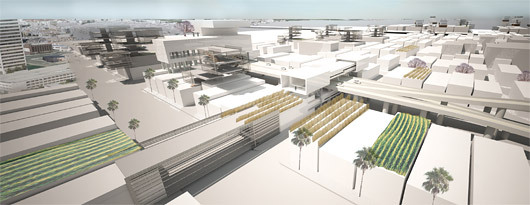

The physical separations between places of work and play have become outdated and burdensome. Meanwhile the divide between commercial, residential, agricultural, and manufacturing zones have become so exaggerated that the infrastructures needed to connect and sustain them crumble in lack of upkeep and congestion. In conjunction with newer, faster transit systems, this plan proposes a simple development strategy that collapses the distances between all the elements needed to support our lifestyles by suggesting that workplaces, as well as production of food and goods, be within walking distance.
2nd Prize: Modular Diffusion
Alan Lu, Yan-ping Wang
University of California, Berkeley


In a car, the passenger can go from any given point to another in one continuous trip. To achieve this level of mobility in tandem with an increase in roadway capacity, we introduce a mass transit system based upon a Modular Transit Vehicle (MTV for short). This modular system would allow passengers to (1) board from a wide range of street stops, (2) travel along the freeway, and (3) take the freeway exit closest to the destination drop passengers off there, all in one ride.
3rd Prize: Freeways Are For Trains
Ben Abelman, Vivian Ngo, Julia Siedle
Columbia University
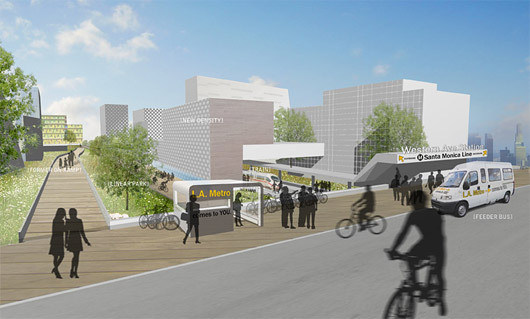
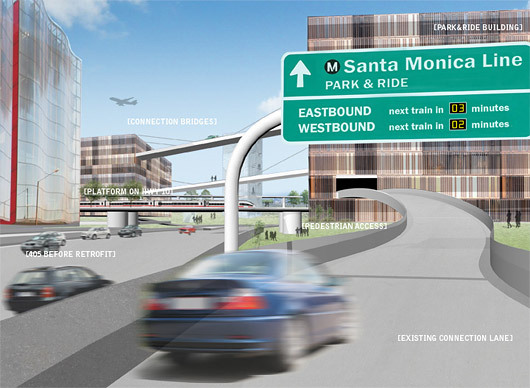
This team believes that Los Angeles need not invest in a “new†public transportation system but transform its existing transportation system of freeways into “trainwaysâ€. By taking over “freeways†with rail tracks, a comprehensive expansion of the LA Metro will respond to the projects that are indicated in Measure R and will commence at a much lower cost due to taking advantage of the rights of ways established by the freeway.
HONORABLE MENTIONS - PROFESSIONAL
Mobility on Demand: RSA: Dwight Bond, Diane Tadena, James Wong
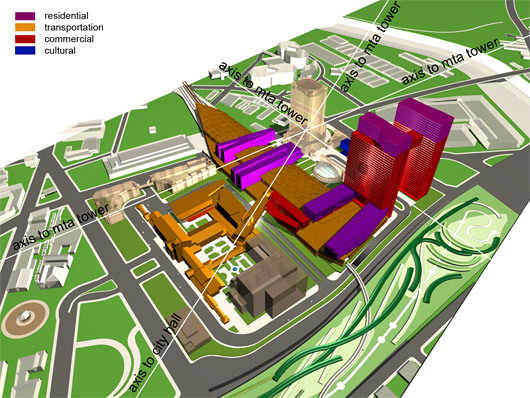
A combination of rail, light-rail, smart cars, bike share, and different bus systems will provide easy connection in and between cities. Multiple vehicle types provide users with choices among combinations of cost, comfort, and functionality. A commuter might choose to ride the train to work, pick up a smart car to attend a meeting, go to the gym, pick up groceries before going back home. In creating a dense commercial and residential environment to support and foster the inevitable expansion of the transit system, the scheme also investigates alternative development strategies that are adaptable to the ever changing conditions of our urban culture.
Green Tech City: NBBJ: Harry Bairamian, Hrant Bairamian, So Eun Cho, Tony Choi, Scott Hunter, Byoung Kweon, Anthony Manzo, Nnamdi Ugenyi, Jonathan Ward, Tim Zamora
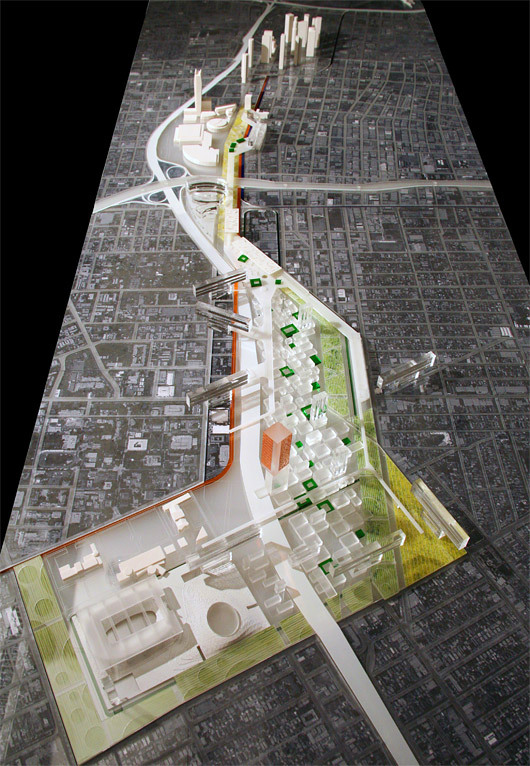
This scheme created green tech districts along the Westside expansion corridor stretching from downtown to Santa Monica. The plan likened itself to a living organism, including a Skeletal System composed of new green districts between stations; a respiratory system that included a 2.5 mile green park along the length of the transit system; and tendons, which were linkages to the community, like freeway bridges, human-scaled densities, walkability plans, urban parks, and agricultural zones.
Go Mixed-Modal: Tom Beresford
http://www.thefunctionality.com/

In 2000, LA Metro gambled that it could increase both ridership and transit efficiency by making a bus a little more like a subway: The Metro Rapid. Mixed-modal goes even further to suggest that any bus has the potential to go “local,†“rapid†or “express†at coordinated points along its route to flexibly serve transit demand. A bus may go “express†by entering grade-separated express lanes shared with planned or existing rail modes, with the help of new friction-less electric power-transfer technologies and hybrid rail/road drive surfaces. The Mixed-modal project offers a vision of what the Expo line might look like if it operated as the “trunk†of a regional transit tree with “branches†extending up and down existing Metro Rapid lines.
HONORABLE MENTIONS - STUDENT
Feeding Community and the Gold Line: Roe Goodman
University of British Columbia

If we are to develop along a freeway we need to keep in mind that the surrounding residential neighborhoods need to access the train in a way that encourages a shift away from car dependency. This entry proposes a string of micro-scale infill developments along a bus line that feeds into the Eastside Transit Corridor. Positioned along newly developed commercial corridors, stops have waiting rooms that store bikes, serve as markets, and create a center of community.
Interstate 10: Tim Do, George LaBeth, Randy Stogsdill
SCI-Arc

This scheme proposes a a reconsideration of the existing freeway corridor as a multi-function transit corridor. The existing freeway would be retrofitted with a new structure above that over a series of stages adds layers of public and environmental friendly transit options. As this second tier becomes more populated, greenscaping is added, converting the freeway corridor into a vibrant public space.
Cross-Link/ Cross-Program: Minjeong Gweon
Cal Poly Pomona

Los Angeles’ current subway network relies too much on a centralized spoke network approach. A more effective subway system should also include cross-linkages. This subway design project looks to develop a new cross-link between the existing red line (which connect Hollywood and Downtown) and the future purple Westside Extension line. The proposed connecting line would add three new stops: the first at Santa Monica Blvd. and Highland Ave, the second at Santa Monica and Fairfax and the third at La Cienega. The connecting point to the red line would be at Hollywood and Highland, and the connecting point to the future purple line would be located at the Beverly Center.
Another project that we found fascinating and worth publishing is “15 Up 15 Down” by Orhan Ayyuce & Glen Small which turns the streets of Los Angeles into oasis canyons. The proposal takes municipal surface streets on the the grid, and doubles their capacity and improves their efficiency. This is supposed to be a system approach with triple store frontage.
15 Up 15 Down: Glen Howard Small & Orhan Ayyuce



Share
0 Comments
Comment as :